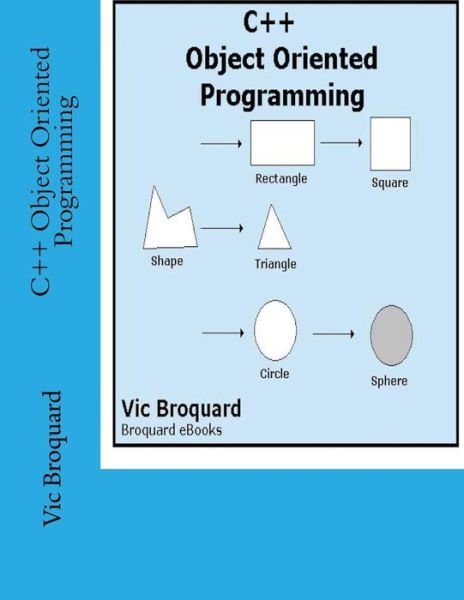
Powiedz znajomym o tym przedmiocie:
C++ Object Oriented Programming Vic Broquard 4. wydanie
C++ Object Oriented Programming
Vic Broquard
The first three chapters of C++ Object Oriented Programming present the iostreams, structures, reference variables, pointers and the use of dynamic memory allocations. These chapters serve as a complete review for those already familiar with C++ basics; however, for those only familiar with C programming, these chapters cover all of the basic extensions of the C++ language. Thus, by the start of chapter 4, all readers should be ready for the OOP portion of the language. The construction of C++ classes are covered in the next two chapters. The approach begins with very simple classes and gradually become more complex as more and more features are added in a gradient manner. After the constructors, destructors and access functions are presented, operator overloaded functions are discussed in the next two chapters. C++ Object Oriented Programming presents the basic operator functions first and in the next chapter, the copy constructor and assignment operator are illustrated along with the usage of dynamic memory allocated member data. Inheritance is similarly split into three chapters. The first chapter shows basic features and problems of inheritance while the second chapter expands into more complex situations that require virtual functions and abstract base classes. The third inheritance chapter is devoted to practical programming examples of inheritance. The next chapter of C++ Object Oriented Programming covers the handling of error situations, followed by a presentation of templates. In the real world, most company data bases are in binary format or in a database, not text files. So the next chapter of C++ Object Oriented Programming covers the principles of binary files. The final chapter of C++ Object Oriented Programming shows an easy technique for class instances to be written in binary format to a file to achieve ?persistence? of an object. The object must, of course, be able to also ?read itself? back into a memory instance. C++ Object Oriented Programming has many complete programming examples. All of these sample programs accompany the book. Each chapter ends with a set of Review Questions and Stop Exercises as well as the expected Programming Problems. The Stop Exercises illustrate many of the common errors beginning OOP programmers make. Thus, if you spend the time to work out the Stop Exercises before beginning work on the actual programming problems, far fewer mistakes occur. The answers to these exercises are also provided. In summary, C++ Object Oriented Programming is a very readable text that grounds one well in object oriented programming and its techniques. It is very application oriented and not a theoretical rewritten language reference manual.
| Media | Książki Paperback Book (Książka z miękką okładką i klejonym grzbietem) |
| Wydane | 29 sierpnia 2014 |
| ISBN13 | 9781941415566 |
| Wydawcy | Broquard eBooks |
| Strony | 616 |
| Wymiary | 216 × 279 × 32 mm · 1,41 kg |
| Język | Angielski |
Więcej od Vic Broquard
Pokaż wszystkoInni również kupili
Zobacz wszystko od Vic Broquard ( np. Paperback Book )

 Świąteczne prezenty można zwracać do 31 stycznia
Świąteczne prezenty można zwracać do 31 stycznia





























![Cover for Vic Broquard · Lindsey Barron Series Volume 7 Cross and Double-cross (Paperback Book) [Second edition] (2014)](https://imusic.b-cdn.net/images/item/original/528/9781941415528.jpg?vic-broquard-2014-lindsey-barron-series-volume-7-cross-and-double-cross-paperback-book&class=scaled&v=1417713804)

![Cover for Vic Broquard · Lindsey Barron Series Volume 6 States Justice (Paperback Book) [Fourth edition] (2014)](https://imusic.b-cdn.net/images/item/original/511/9781941415511.jpg?vic-broquard-2014-lindsey-barron-series-volume-6-states-justice-paperback-book&class=scaled&v=1418669624)
![Cover for Vic Broquard · Lindsey Barron Series Volume 4 Dominus for President (Paperback Book) [Fourth edition] (2014)](https://imusic.b-cdn.net/images/item/original/498/9781941415498.jpg?vic-broquard-2014-lindsey-barron-series-volume-4-dominus-for-president-paperback-book&class=scaled&v=1418669625)
![Cover for Vic Broquard · Lindsey Barron Series Volume 5 the National Health Care Program (Paperback Book) [Fourth edition] (2014)](https://imusic.b-cdn.net/images/item/original/504/9781941415504.jpg?vic-broquard-2014-lindsey-barron-series-volume-5-the-national-health-care-program-paperback-book&class=scaled&v=1413176603)
![Cover for Vic Broquard · Lindsey Barron Series Volume 3 the Crown of Moses (Paperback Book) [Fourth edition] (2014)](https://imusic.b-cdn.net/images/item/original/481/9781941415481.jpg?vic-broquard-2014-lindsey-barron-series-volume-3-the-crown-of-moses-paperback-book&class=scaled&v=1418669627)

![Cover for Christopher Paolini · Brisingr (The Inheritance Cycle) (Paperback Book) [Reprint edition] (2010)](https://imusic.b-cdn.net/images/item/original/740/9780375826740.jpg?christopher-paolini-2010-brisingr-the-inheritance-cycle-paperback-book&class=scaled&v=1408594505)
![Cover for Paolini Christopher · Eldest (Paperback Book) [Reprint edition] (2007)](https://imusic.b-cdn.net/images/item/original/401/9780375840401.jpg?paolini-christopher-2007-eldest-paperback-book&class=scaled&v=1408609254)
